Annex I
List of the names, pharmaceutical form, strength of the medicinal products,
route of administration, Marketing Authorisation Holders in the Member
States
1

Member
State
EU/EEA
Marketing authorisation
holder
(Invented) Name Strength Pharmaceutical form
Route of
administration
Content
(concentration)
Austria Merck Sharp & Dohme
Ges.m.b.H.
Am Euro Platz 2
1120 Wien
Austria
Nasonex aquosum -
Nasenspray
50 μg/
actuation
Nasal spray, suspension Nasal use 0.05% w/w
Mometasone
furoate calculated
on the anhydrous
basis
Belgium MSD Belgium BVBA/SPRL
Clos du Lynx 5
B-1200 Bruxelles
Belgium
Nasonex 50 μg/
actuation
Nasal spray, suspension Nasal use 0.05% w/w
Mometasone
furoate calculated
on the anhydrous
basis
Bulgaria Merck Sharp and Dohme
Bulgaria EOOD
55, Nikola Vaptzarov blvd.
EXPO 2000, East Wing,
Sectors B1 & B2
1407 Sofia
Bulgaria
NASONEX 50 μg/
actuation
Nasal spray, suspension Nasal use 0.05% w/w
Mometasone
furoate calculated
on the anhydrous
basis
Croatia
Merck Sharp & Dohme d.o.o.
Heinzelova 62a
10 000 Zagreb
Croatia
Nasonex 50 μg/
actuation
Nasal spray, suspension Nasal use 0.05% w/w
Mometasone
furoate calculated
on the anhydrous
basis
2

Member
State
EU/EEA
Marketing authorisation
holder
(Invented) Name Strength Pharmaceutical form
Route of
administration
Content
(concentration)
Czech
Republic
Merck Sharp & Dohme B.V.
Waarderweg 39
2031 BN Haarlem
The Netherlands
NASONEX 50 μg/dose Nasal spray, suspension Nasal use 0.05% w/w
Mometasone
furoate calculated
on the anhydrous
basis
Denmark Merck Sharp & Dohme BV
Waarderweg 39
Postbox 581
2003 PC Haarlem
The Netherlands
Nasonex 50 μg/
actuation
Nasal spray, suspension Nasal use 0.05% w/w
Mometasone
furoate calculated
on the anhydrous
basis
Estonia Merck Sharp & Dohme B.V.
Waarderweg 39
2031 BN Haarlem
The Netherlands
Nasonex 50 μg/
actuation
Nasal spray, suspension Nasal use 0.05% w/w
Mometasone
furoate calculated
on the anhydrous
basis
Finland Merck Sharp & Dohme B.V.
Box 581
2003 PC Haarlem
The Netherlands
Nasonex 50 μg/
actuation
Nasal spray, suspension Nasal use 0.05% w/w
Mometasone
furoate calculated
on the anhydrous
basis
France MSD France
34 avenue Léonard de Vinci
92400 Courbevoie
France
Nasonex 50 μg/
actuation
Nasal spray, suspension Nasal use 0.05% w/w
Mometasone
furoate calculated
on the anhydrous
basis
3

Member
State
EU/EEA
Marketing authorisation
holder
(Invented) Name Strength Pharmaceutical form
Route of
administration
Content
(concentration)
Germany MSD SHARP & DOHME
GMBH
Lindenplatz 1
85540 Haar
Germany
Nasonex 50 μg/
actuation
Nasal spray, suspension Nasal use 0.05% w/w
Mometasone
furoate calculated
on the anhydrous
basis
Greece Merck Sharp & Dohme S.A.
Ag. Dimitriou 63
174 56 Alimos
Greece
Nasonex 50 μg/
actuation
Nasal spray, suspension Nasal use 0.05% w/w
Mometasone
furoate calculated
on the anhydrous
basis
Hungary MSD Pharma Hungary Kft.
H-1095 Budapest
Lechner Ödön fasor 8.
Hungary
Nasonex 50 μg/
actuation
Nasal spray, suspension Nasal use 0.05% w/w
Mometasone
furoate calculated
on the anhydrous
basis
Iceland Merck Sharp & Dohme B.V.
Box 581
2003 PC Haarlem
The Netherlands
Nasonex 50 μg/
actuation
Nasal spray, suspension Nasal use 0.05% w/w
Mometasone
furoate calculated
on the anhydrous
basis
4

Member
State
EU/EEA
Marketing authorisation
holder
(Invented) Name Strength Pharmaceutical form
Route of
administration
Content
(concentration)
Ireland Merck Sharp & Dohme
Ireland (Human Health)
Limited
Red Oak North
South County Business Park
Leopardstown
Dublin 18
Ireland
Nasonex 50 μg/
actuation
Nasal Spray, Suspension Nasal use 0.05% w/w
Mometasone
furoate calculated
on the anhydrous
basis
Italy MSD Italia S.r.l.
Via Vitorchiano 151
00189 Roma
Italy
Nasonex 50 μg/
actuation
Nasal Spray, Suspension Nasal use 0.05% w/w
Mometasone
furoate calculated
on the anhydrous
basis
Italy Malesci Istituto
Farmacobiologico S.p.A
Via Lungo l’Ema 7
Bagno a Ripoli (FI)
Italy
Rinelon 50 μg/
actuation
Nasal Spray, Suspension Nasal use 0.05% w/w
Mometasone
furoate calculated
on the anhydrous
basis
Latvia Merck Sharp & Dohme B.V.
Waarderweg 39
2031 BN Haarlem
The Netherlands
Nasonex 50
mikrogrami/devā
deguna aerosols,
suspensija
50 μg/dose Nasal spray, suspension Nasal use 0.05% w/w
Mometasone
furoate calculated
on the anhydrous
basis
5

Member
State
EU/EEA
Marketing authorisation
holder
(Invented) Name Strength Pharmaceutical form
Route of
administration
Content
(concentration)
Lithuania Merck Sharp & Dohme B.V.
Waarderweg 39
2031 BN Haarlem
The Netherlands
Nasonex 50 μg/
dose
Nasal spray, suspension Nasal use 0.05% w/w
Mometasone
furoate
(monohydrate)
calculated on the
anhydrous basis
Luxembourg MSD Belgium BVBA/SPRL
Clos du Lynx 5
B-1200 Bruxelles
Belgium
Nasonex 50 μg/
actuation
Nasal spray, suspension Nasal use 0.05% w/w
Mometasone
furoate calculated
on the anhydrous
basis
Malta Merck Sharp & Dohme Ltd.
Hertford Road
Hoddesdon
Hertfordshire
EN11 9BU
United Kingdom
Nasonex 50 μg/
actuation
Nasal spray, suspension Nasal use 0.05% w/w
Mometasone
furoate calculated
on the anhydrous
basis
Netherlands Merck Sharp & Dohme B.V.
Waarderweg 39
2031 BN Haarlem
The Netherlands
Nasonex 50 μg/
actuation
Nasal spray, suspension Nasal use 0.05% w/w
Mometasone
furoate calculated
on the anhydrous
basis
Norway Merck Sharp & Dohme B.V.
Waarderweg 39
2031 BN Haarlem
The Netherlands
Nasonex 50 μg/
actuation
Nasal spray, suspension Nasal use 0.05% w/w
Mometasone
furoate calculated
on the anhydrous
basis
6

Member
State
EU/EEA
Marketing authorisation
holder
(Invented) Name Strength Pharmaceutical form
Route of
administration
Content
(concentration)
Poland MSD Polska Sp. z o.o.
ul. Chłodna 51
00-867 Warszawa
Poland
Nasonex 50 μg/
dose
Nasal spray, suspension Nasal use 0.05% w/w
Mometasone
furoate calculated
on the anhydrous
basis
Portugal Merck Sharp & Dohme, Lda.
Quinta da Fonte, 19
Edifício Vasco da Gama
2770-192 Paço de Arcos
Portugal
Nasomet 50 μg/
dose
Nasal spray, suspension Nasal use 0.05% w/w
Mometasone
furoate calculated
on the anhydrous
basis
Romania MERCK SHARP & DOHME
ROMANIA S.R.L.
Bucharest Business Park
Şos. Bucureşti-Ploieşti Nr.
1A, Clădirea C1, Etaj 3,
Sector 1, Bucureşti
Romania
NASONEX 50 μg/
dose
Nasal spray, suspension Nasal use 0.05% w/w
Mometasone
furoate calculated
on the anhydrous
basis
Slovak
Republic
Merck Sharp & Dohme B.V.
Waarderweg 39
2031 BN Haarlem
P.O. Box 581
2003 PC Haarlem
The Netherlands
NASONEX 50 μg/
actuation
Nasal spray, suspension Nasal use 0.05% w/w
Mometasone
furoate calculated
on the anhydrous
basis
7

Member
State
EU/EEA
Marketing authorisation
holder
(Invented) Name Strength Pharmaceutical form
Route of
administration
Content
(concentration)
Slovenia Merck Sharp & Dohme,
inovativna zdravila d.o.o.
Šmartinska cesta 140
1000 Ljubljana
Slovenia
NASONEX 50 μg/
actuation
Nasal spray, suspension Nasal use 0.05% w/w
Mometasone
furoate calculated
on the anhydrous
basis
Spain Merck Sharp & Dohme de
España, S.A.
C/ Josefa Valcárcel, 38
28027 Madrid
Spain
NASONEX 50
microgramos
suspension para
pulverización nasal
50 μg/
actuation
Nasal Spray, Suspension Nasal use 0.05% w/w
Mometasone
furoate calculated
on the anhydrous
basis
Spain Desarrollos Farmacéuticos y
Cosméticos, S.A.
C/ Josefa Valcárcel, 38
28027 Madrid
Spain
Mometasona MSD
50 microgramos
suspensión para
pulverización nasal
50 μg/
actuation
Nasal Spray, Suspension Nasal use 0.05% w/w
Mometasone
furoate calculated
on the anhydrous
basis
Sweden Merck Sharp & Dohme B.V.
Box 581
2003 PC Haarlem
The Netherlands
Nasonex 50 μg/
dose
Nasal spray, suspension Nasal use 0.05% w/w
Mometasone
furoate calculated
on the anhydrous
basis
8

Member
State
EU/EEA
Marketing authorisation
holder
(Invented) Name Strength Pharmaceutical form
Route of
administration
Content
(concentration)
United
Kingdom
Merck Sharp & Dohme Ltd
Hertford Road
Hoddesdon
Hertfordshire
EN11 9BU
United Kingdom
Nasonex 50 μg/
actuation
Nasal Spray, Suspension Nasal use 0.05% w/w
Mometasone
furoate calculated
on the anhydrous
basis
9
Annex II
Scientific conclusions and grounds for the variation to the terms of the
Marketing Authorisation
10

Scientific conclusions
Overall summary of the scientific evaluation of Nasonex and associated names (see Annex I)
The active ingredient of Nasonex, mometasone furoate monohydrate is a synthetic, 17-heterocyclic
corticosteroid with anti-inflammatory activity. Nasonex Nasal Spray 50 mcg is a metered-dose, manual
pump spray unit containing an aqueous suspension of mometasone furoate monohydrate equivalent to
0.05% w/w mometasone furoate; in an aqueous medium containing glycerin, microcrystalline cellulose
and carboxymethylcellulose sodium, sodium citrate, citric acid, benzalkonium chloride, and polysorbate
80.
Nasonex medicinal products are registered in the following EU Members States: Austria, Belgium,
Bulgaria, Czech Republic, Denmark, Estonia, Finland, France, Germany, Greece, Hungary, Ireland,
Italy, Latvia, Lithuania, Luxembourg, Malta, the Netherlands, Poland, Portugal, Romania, Slovakia,
Slovenia, Spain, Sweden and United Kingdom and also in Iceland and Norway.
Nasonex medicinal products are currently not registered in Cyprus.
It was authorised according to the national procedure in 16 European countries and according to the
mutual recognition procedure (MRP) in 13 Member States, with the United Kingdom (UK) acting as
reference Member State (RMS).
Due to the divergent national decisions taken by Member States concerning the authorisation of
Nasonex and associated names, the European Commission (EC) notified the European Medicines
Agency of an official referral under Article 30 of Directive 2001/83/EC in order to resolve divergences
amongst the authorised SmPCs for the above-mentioned product, and thus to harmonise the SmPCs
across the EU.
Summary of product characteristics (SmPC)
The MAH has proposed the current MRP PI that is supported by the available efficacy and safety data,
as the basis for the harmonized PI.
Section 4.1 – Therapeutic Indications
Treatment of symptoms of rhinitis
Seasonal allergic rhinitis
Six studies were conducted to demonstrate the efficacy of mometasone furoate in 2544 patients with
seasonal allergic rhinitis randomised to treatment with mometasone furoate, placebo or active control.
Of the 6 studies, 4 were pooled, and the patient diary results showed a reduction from baseline of 33%
compared to 15% in placebo-treated patients in the first 2 weeks of treatment with mometasone
furoate. The mean scores for physician evaluations of total nasal symptoms showed greater reductions
for mometasone furoate at all visits (ranging from 36 to 62%) compared to placebo (22% to 48%).
Perennial rhinitis
Based on the 9 studies in the original perennial rhinitis program, the perennial rhinitis indication was
approved for MRP countries in 1997, and by the other concerned Member States between 1997 and
1998. Subsequently, a study Q97-921 specifically in subjects with perennial non-allergic rhinitis
(PNAR) was completed indicating a positive outcome, and resulting in an indication for PNAR being
granted in May 2000 in Sweden.
These studies support the proposed indication for the symptomatic treatment of rhinitis (seasonal
allergic and perennial) in adults.
11

Paediatric population
Information on the paediatric program and the study results (efficacy and safety) has been provided by
the MAH. The overall response in terms of improvement from baseline was shown to be similar
between the 3- to 5-year-old and 6- to 11-year-old subgroups. Thus there is support for efficacy in the
age group 3-5 years, and no difference in efficacy is to be expected in a 3 year old as compared to a 6
year old from a pharmacological perspective. Therefore the use of mometasone furoate in perennial
rhinitis in children over 3 years of age was considered to be acceptable by the CHMP as proposed by
the MAH.
Prophylaxis of seasonal allergic rhinitis
Two randomised multicentre clinical studies from the MRP dossier have been referred to, where
mometasone furoate was administered to patients with a history of seasonal allergic rhinitis. The
submitted studies are not considered to support the prophylaxis of seasonal allergic rhinitis, since the
data submitted for this indication are not conclusive with regard to the appropriate time point for start
of treatment, considering that early start of treatment was not compared to starting at the time of
symptom onset. The onset of action of mometasone furoate in patients with allergic symptoms is rapid,
and hence the observed effect after prophylactic treatment (as defined in the studies) could be related
to a treatment effect as covered by the general rhinitis indication. Therefore the indication for the
prophylaxis of seasonal allergic rhinitis was not accepted by the CHMP. Instead, text was introduced in
Section 4.2 of the SmPC to clarify that treatment may need to be initiated a few days before the
expected onset of the allergy season in patients with a history of moderate to severe symptoms of
seasonal allergic rhinitis.
Nasal polyposis
Two 4-month randomized, placebo-controlled, double-blind, parallel-group multicentre, efficacy and
safety treatment trials and a no-treatment, observational, follow-up study have been discussed in
support of the indication for the treatment of nasal polyposis, where two doses of mometasone furoate
compared with placebo (200 µg QD and BID) were investigated in a total of 664 subjects, of which 441
were treated with mometasone furoate. The indication for the treatment of nasal polyposis was
accepted by the CHMP.
The MAH has chosen not to include the indication for the prevention of nasal polyp relapse after
functional endoscopic sinus surgery (FESS) in the proposed harmonized SmPC, which is approved only
in Sweden.
Treatment of acute sinusitis
Two studies investigating sinusitis and also the results and analysis of an additional study (A2-3852)
conducted to assess the clinical relevance of the observed effect size of the treatment showed that the
clinical relevance of the data generated in these studies with respect to the indication proposed had
not been established. Therefore the indication for the treatment acute sinusitis was not accepted by
the CHMP.
Section 4.2 - Posology and method of administration
On the basis of 19 Phase II and III studies completed using mometasone furoate in adolescents and
adults, a total dose 200 µg once daily was chosen as the standard clinical adolescent/adult dosage,
allowing dose titration up to a maximum daily total dose of 400 mg.
The initial dose for rhinitis and nasal polyps is 100 µg once daily in each nostril (total daily dose of 200
µg). In case of inadequate response a dose increase to 100 µg twice daily in each nostril (total daily
dose of 400 µg) has been proposed as in most Member States.
12
In patients who have a history of moderate to severe symptoms of seasonal allergic rhinitis, it is
recommended that mometasone furoate may need to be initiated some days before the expected start
of the pollen season.
Paediatric population
The safety and efficacy of Nasonex Nasal Spray has not been established in:
- children under 3 years of age in seasonal allergic rhinitis and perennial allergic rhinitis
- children and adolescents under 18 years of age have not been established in nasal polyposis.
The text in section 4.2 has been revised and aligned with the QRD requirements.
Section 4.3 – Contraindications
Known hypersensitivity to the active substance, mometasone furoate, or to any of the excipients has
been proposed as per the current Guideline on the Summary of Product Characteristics.
Mometasone furoate is contraindicated in the presence of untreated localised infection such as herpes
simplex, involving the nasal mucosa, and also in patients who have experienced recent nasal surgery
or trauma until healing has occurred because of the inhibitory effect of corticosteroids on wound
healing.
Section 4.4 - Special warnings and precautions for use
The content of this section has not been changed from what is approved in most countries although
the wordings have in some cases been amended to achieve harmonisation.
Mention is made of the immunosuppressive effects of corticosteroids and the risk of exposure of
patients to certain infections (e.g., chickenpox, measles), and of the importance of obtaining medical
advice if such exposure occurs.
Mometasone furoate is not recommended for use in case of nasal septum perforation (the reported
instances of nasal septum perforation information is mentioned in section 4.8). The higher incidence of
epitaxis observed in clinical studies is also mentioned in this section as well as in section 4.8. In
addition, this section gives warning concerning the presence of benzalkonium chloride excipient, which
may cause nasal irritation.
A section on the systemic effects of corticosteroids including as well as reports of increased intraocular
pressure following the use of intranasal corticosteroids has also been mentioned. The need for
concomitant use of appropriate additional therapy for additional relief of non-nasal symptoms,
particularly ocular symptoms, is also highlighted.
It is also recommended that the effect on growth in the paediatric population is regularly monitored
with prolonged treatment with nasal corticosteroids.
Section 4.5- Interaction with other medicinal products and other forms of interaction
Reference is made to a clinical interaction study was conducted with loratadine where no interactions
were reported to have been observed.
A cross reference to section 4.4 for use with systemic corticosteroids is made.
Section 4.6 – Fertility, pregnancy and lactation
The wording proposed by the MAH under the subheadings ‘Pregnancy’ and ‘Lactation’ was considered
to be acceptable by the CHMP.
13

The section on ‘Fertility’ was amended to include only the relevant conclusions from non-clinical
toxicity studies in accordance with current Guideline on the summary of product characteristics.
Section 4.7 - Effects on ability to drive and use machines
The statement that there are no known effects on the ability to drive and use machines was considered
to be acceptable by the CHMP.
Section 4.8 - Undesirable effects
Section 4.8 was restructured as suggested by the CHMP to increase readability and to comply with the
QRD template and SmPC guideline. The adverse events were presented independently of the indication
and presenting all data (pooled) in a single tabulated format.
Section 4.9 – Overdose
It is stated that overdose is unlikely to require any therapy other than observation since the systemic
bioavailability of mometasone furoate is <1%. However inhalation or oral administration of excessive
doses of corticosteroids may lead to suppression of HPA axis function.
Section 5.1 - Pharmacodynamic properties
This section of the proposed SmPC contains information on the mechanism of action of mometasone
furoate, and its pharmacodynamic effects in patients with seasonal allergic rhinitis.
The European Medicines Agency has waived the obligation to submit the results of studies with
Nasonex Nasal Spray and associated names in all subsets of the paediatric population in seasonal and
perennial allergic rhinitis (see section 4.2 for information on paediatric use).
Section 5.2 - Pharmacokinetic properties
The information proposed by the MAH in this section of the SmPC was listed under the headings
absorption, distribution, biotransformation and elimination, and was considered to be acceptable by the
CHMP, with the recommended amendments.
Section 5.3 - Preclinical safety data
The glucocorticoid-related effects of mometasone furoate observed in animal studies are described in
this section.
Mometasone furoate is devoid of androgenic, antiandrogenic, estrogenic or antiestrogenic activity. No
toxicological effects unique to mometasone furoate exposure were demonstrated.
Package Leaflet (PL)
The changes to the SmPC, when relevant for the user, have also been reflected in the PL and agreed
by the CHMP.
The results obtained for the user testing in variation UK/H/0196/001/II/032 submitted as a
commitment to a renewal in the (MRP) and approved in January 2009, were considered acceptable by
the CHMP.
Nasonex is a nasal preparation for topical use and contains benzalkonium chloride. As the amount of
benzalkonium chloride - 0.02 mg per actuation is above the threshold of 10 micrograms /delivered
dose, a statement that Nasonex contains benzalkonium chloride, which may cause nasal irritation is
included in the PL, in accordance with the Guideline on Excipients in the label and PL (2003).
14
Grounds for the variation to the terms of the marketing authorisation(s)
Whereas
• The committee considered the referral under Article 30 of Directive 2001/83/EC
• The committee considered the identified divergences for the Nasonex and associated names
with respect to the sections therapeutic indications, posology and method of administration, as
well as the remaining sections of the SmPC.
• The committee reviewed the data submitted by the MAH from the existing clinical and non-
clinical studies and post-marketing experience with Nasonex and associated names as reported
by the MAH justifying the proposed harmonisation of the product information.
• The committee agreed with the harmonised summary of product characteristic, labelling and
package leaflet proposed and discussed by the marketing authorisation holder.
the CHMP has recommended the variation to the terms of the marketing authorisations for which the
summary of product characteristics, labelling and package leaflet are set out in Annex III for Nasonex
and associated names (see Annex I).
15
Annex III
Summary of product characteristics, labelling and package leaflet
Note:
This Summary of Product Characteristics, labelling and package leaflet is the outcome of the referral
procedure to which this Commission decision relates.
The product information may be subsequently updated by the Member State competent authorities, in
liaison with the Reference Member State, as appropriate, in accordance with the procedures laid down
in Chapter 4 of Title III of Directive 2001/83/EC.
16
SUMMARY OF PRODUCT CHARACTERISTICS,
LABELLING AND PACKAGE LEAFLET
17
SUMMARY OF PRODUCT CHARACTERISTICS
18

1. NAME OF THE MEDICINAL PRODUCT
NASONEX and associated names strength pharmaceutical form
[See Annex I - To be completed nationally]
2. Q
UALITATIVE AND QUANTITATIVE COMPOSITION
Mometasone furoate (as the monohydrate) 50 micrograms/actuation.
Excipient with known effect:
This medicinal product contains 0.02 mg of benzalkonium chloride per actuation.
For the full list of excipients, see section 6.1.
3. P
HARMACEUTICAL FORM
Nasal Spray, Suspension.
White to off-white opaque suspension.
4. C
LINICAL PARTICULARS
4.1 Therapeutic indications
NASONEX Nasal Spray is indicated for use in adults and children 3 years of age and older to treat the
symptoms of seasonal allergic or perennial rhinitis.
NASONEX Nasal Spray is indicated for the treatment of nasal polyps in adults 18 years of age and older.
• 4.2 Posology and method of administration
After initial priming of the NASONEX Nasal Spray pump, each actuation delivers approximately 100 mg of
mometasone furoate suspension, containing mometasone furoate monohydrate equivalent to 50 micrograms
mometasone furoate.
Posology
Seasonal Allergic or Perennial Rhinitis
Adults (including older patients) and children 12 years of age and older: The usual recommended dose is two
actuations (50 micrograms/actuation) in each nostril once daily (total dose 200 micrograms). Once symptoms
are controlled, dose reduction to one actuation in each nostril (total dose 100 micrograms) may be effective
for maintenance. If symptoms are inadequately controlled, the dose may be increased to a maximum daily
dose of four actuations in each nostril once daily (total dose 400 micrograms). Dose reduction is
recommended following control of symptoms.
Children between the ages of 3 and 11 years: The usual recommended dose is one actuation
(50 micrograms/actuation) in each nostril once daily (total dose 100 micrograms).
NASONEX Nasal Spray demonstrated a clinically significant onset of action within 12 hours after the first
dose in some patients with seasonal allergic rhinitis; however, full benefit of treatment may not be achieved in
the first 48 hours. Therefore, the patient should continue regular use to achieve full therapeutic benefit.
Treatment with NASONEX Nasal Spray may need to be initiated some days before the expected start of the
19

pollen season in patients who have a history of moderate to severe symptoms of seasonal allergic rhinitis.
Nasal Polyposis
The usual recommended starting dose for polyposis is two actuations (50 micrograms/actuation) in each
nostril once daily (total daily dose of 200 micrograms). If after 5 to 6 weeks symptoms are inadequately
controlled, the dose may be increased to a daily dose of two sprays in each nostril twice daily (total daily dose
of 400 micrograms). The dose should be titrated to the lowest dose at which effective control of symptoms is
maintained. If no improvement in symptoms is seen after 5 to 6 weeks of twice daily administration, the
patient should be re-evaluated and treatment strategy reconsidered.
Efficacy and Safety studies of NASONEX Nasal Spray for the treatment of nasal polyposis were four months
in duration.
Paediatric population
Seasonal Allergic Rhinitis and Perennial Rhinitis
The safety and efficacy of NASONEX Nasal Spray in children under 3 years of age have not been
established.
Nasal Polyposis
The safety and efficacy of NASONEX Nasal Spray in children and adolescents under 18 years of age have not
been established.
Method of administration
Prior to administration of the first dose, shake container well and actuate the pump 10 times (until a uniform
spray is obtained). If the pump is not used for 14 days or longer, reprime the pump with 2 actuations until a
uniform spray is observed, before next use.
Shake container well before each use. The bottle should be discarded after the labelled number of actuations
or within 2 months of first use.
4.3 Contraindications
Hypersensitivity to the active substance, mometasone furoate, or to any of the excipients listed in section 6.1.
NASONEX Nasal Spray should not be used in the presence of untreated localised infection involving the
nasal mucosa, such as herpes simplex.
Because of the inhibitory effect of corticosteroids on wound healing, patients who have experienced recent
nasal surgery or trauma should not use a nasal corticosteroid until healing has occurred.
4.4 Special warnings and precautions for use
Immunosuppression
NASONEX Nasal Spray should be used with caution, if at all, in patients with active or quiescent tuberculous
infections of the respiratory tract, or in untreated fungal, bacterial, or systemic viral infections.
Patients receiving corticosteroids who are potentially immunosuppressed should be warned of the risk of
exposure to certain infections (e.g., chickenpox, measles) and of the importance of obtaining medical advice if
such exposure occurs.
Local Nasal Effects
Following 12 months of treatment with NASONEX Nasal Spray in a study of patients with perennial rhinitis,
there was no evidence of atrophy of the nasal mucosa; also, mometasone furoate tended to reverse the nasal
20

mucosa closer to a normal histologic phenotype. Nevertheless, patients using NASONEX Nasal Spray over
several months or longer should be examined periodically for possible changes in the nasal mucosa. If
localised fungal infection of the nose or pharynx develops, discontinuance of NASONEX Nasal Spray therapy
or appropriate treatment may be required. Persistence of nasopharyngeal irritation may be an indication for
discontinuing NASONEX Nasal Spray.
Nasonex is not recommended in case of nasal septum perforation (see section 4.8).
In clinical studies, epistaxis occurred at a higher incidence compared to placebo. Epistaxis was generally
self-limiting and mild in severity (see section 4.8).
NASONEX Nasal Spray contains benzalkonium chloride which may cause nasal irritation.
Systemic Effects of Corticosteroids
Systemic effects of nasal corticosteroids may occur, particularly at high doses prescribed for prolonged
periods. These effects are much less likely to occur than with oral corticosteroids and may vary in
individual patients and between different corticosteroid preparations. Potential systemic effects may
include Cushing’s syndrome, Cushingoid features, adrenal suppression, growth retardation in children and
adolescents, cataract, glaucoma and more rarely, a range of psychological or behavioural effects including
psychomotor hyperactivity, sleep disorders, anxiety, depression or aggression (particularly in children).
Following the use of intranasal corticosteroids, instances of increased intraocular pressure have been reported
(see section 4.8).
There is no evidence of hypothalamic-pituitary-adrenal (HPA) axis suppression following prolonged
treatment with NASONEX Nasal Spray. However, patients who are transferred from long-term
administration of systemically active corticosteroids to NASONEX Nasal Spray require careful attention.
Systemic corticosteroid withdrawal in such patients may result in adrenal insufficiency for a number of
months until recovery of HPA axis function. If these patients exhibit signs and symptoms of adrenal
insufficiency or symptoms of withdrawal (e.g., joint and/or muscular pain, lassitude, and depression initially)
despite relief from nasal symptoms, systemic corticosteroid administration should be resumed and other
modes of therapy and appropriate measures instituted. Such transfer may also unmask pre-existing allergic
conditions, such as allergic conjunctivitis and eczema, previously suppressed by systemic corticosteroid
therapy.
Treatment with higher than recommended doses may result in clinically significant adrenal suppression. If
there is evidence for higher than recommended doses being used, then additional systemic corticosteroid
cover should be considered during periods of stress or elective surgery.
Nasal Polyps
The safety and efficacy of NASONEX Nasal Spray has not been studied for use in the treatment of
unilateral polyps, polyps associated with cystic fibrosis, or polyps that completely obstruct the nasal
cavities.
• Unilateral polyps that are unusual or irregular in appearance, especially if ulcerating or bleeding,
should be further evaluated.
Effect on Growth in Paediatric Population
It is recommended that the height of children receiving prolonged treatment with nasal corticosteroids is
regularly monitored. If growth is slowed, therapy should be reviewed with the aim of reducing the dose of
nasal corticosteroid if possible, to the lowest dose at which effective control of symptoms is maintained. In
addition, consideration should be given to referring the patient to a paediatric specialist.
21

Non-nasal Symptoms
Although NASONEX Nasal Spray will control the nasal symptoms in most patients, the concomitant use of
appropriate additional therapy may provide additional relief of other symptoms, particularly ocular symptoms.
4.5 Interactions with other medicaments and other forms of interaction
(See 4.4 Special warnings and special precautions for use with systemic corticosteroids)
A clinical interaction study was conducted with loratadine. No interactions were observed.
4.6 Fertility, pregnancy and lactation
Pregnancy
There are no or limited amount of data from the use of mometasone furoate in pregnant women. Studies in
animals have shown reproductive toxicity (see section 5.3). As with other nasal corticosteroid preparations,
NASONEX Nasal Spray should not be used in pregnancy unless the potential benefit to the mother justifies
any potential risk to the mother, foetus or infant. Infants born of mothers who received corticosteroids during
pregnancy should be observed carefully for hypoadrenalism.
Lactation
It is unknown whether mometasone furoate is excreted in human milk. As with other nasal corticosteroid
preparations, a decision must be made whether to discontinue breast-feeding or to discontinue/abstain from
NASONEX Nasal Spray therapy taking into account the benefit of breast feeding for the child and the
benefit of therapy for the woman.
Fertility
There are no clinical data concerning the effect of mometasone furoate on fertility. Animal studies have
shown reproductive toxicity, but no effects on fertility (see section 5.3).
4.7 Effects on ability to drive and use machines
None known.
4.8 Undesirable effects
Summary of the safety profile
Epistaxis was generally self-limiting and mild in severity, and occurred at a higher incidence compared to
placebo (5%), but at a comparable or lower incidence when compared to the active control nasal
corticosteroids studied (up to 15%) as reported in clinical studies for allergic rhinitis. The incidence of all
other adverse events was comparable with that of placebo. In patients treated for nasal polyposis, the
overall incidence of adverse events was similar to that observed for patients with allergic rhinitis.
Systemic effects of nasal corticosteroids may occur, particularly when prescribed at high doses for prolonged
periods.
Tabulated list of adverse reactions
Treatment related adverse reactions (≥1%) reported in clinical trials in patients with allergic rhinitis or nasal
polyposis and post-marketing regardless of indication are presented in Table 1. Adverse reactions are listed
according to MedDRA primary system organ class. Within each system organ class, adverse reactions are
ranked by frequency. Frequencies were defined as follows: Very common (≥1/10); common (≥1/100 to
<1/10); uncommon (≥1/1,000 to <1/100). The frequency of post-marketing adverse events are considered as
“not known (cannot be estimated from the available data)”.
22

Table 1: Treatment-related adverse reactions reported by system organ class and frequency
Very common
Common
Not known
Infections and
infestations
Pharyngitis
Upper respiratory tract
infection
†
Immune system
disorders
Hypersensitivity
including anaphylactic
reactions, angioedema,
bronchospasm, and
dyspnoea
Nervous system
disorders
Headache
Eye disorders
Glaucoma
Increased intraocular
pressure
Cataracts
Respiratory, thoracic
and mediastinal
disorders
Epistaxis*
Epistaxis
Nasal burning
Nasal irritation
Nasal ulceration
Nasal septum perforation
Gastrointestinal
disorders
Throat irritation*
Disturbances of taste
and smell
*recorded for twice daily dosing for nasal polyposis
†
recorded at uncommon frequency for twice daily dosing for nasal polyposis
Paediatric population
In the paediatric population, the incidence of recorded adverse events in clinical studies, e.g., epistaxis
(6%), headache (3%), nasal irritation (2%) and sneezing (2%) was comparable to placebo.
Reporting of suspected adverse reactions
Reporting suspected adverse reactions after authorisation of the medicinal product is important. It allows
continued monitoring of the benefit/risk balance of the medicinal product. Healthcare professionals are
asked to report any suspected adverse reactions via the national reporting system listed in Appendix V.
4.9 Overdose
Symptoms
Inhalation or oral administration of excessive doses of corticosteroids may lead to suppression of HPA axis
function.
Management
Because the systemic bioavailability of NASONEX Nasal Spray is <1%, overdose is unlikely to require any
therapy other than observation, followed by initiation of the appropriate prescribed dosage.
5. P
HARMACOLOGICAL PROPERTIES
5.1 Pharmacodynamic properties
Pharmacotherapeutic group: Decongestants and Other Nasal Preparations for Topical Use-Corticosteroids,
ATC code: R01A D09
23

Mechanism of action
Mometasone furoate is a topical glucocorticosteroid with local anti-inflammatory properties at doses that are
not systemically active.
It is likely that much of the mechanism for the anti-allergic and anti-inflammatory effects of mometasone
furoate lies in its ability to inhibit the release of mediators of allergic reactions. Mometasone furoate
significantly inhibits the release of leukotrienes from leucocytes of allergic patients. In cell culture,
mometasone furoate demonstrated high potency in inhibition of synthesis and release of IL-1, IL-5, IL-6 and
TNFα; it is also a potent inhibitor of leukotriene production. In addition, it is an extremely potent inhibitor of
the production of the Th2 cytokines, IL-4 and IL-5, from human CD4+ T-cells.
Pharmacodynamic effects
In studies utilising nasal antigen challenge, NASONEX Nasal Spray has shown anti-inflammatory activity in
both the early- and late- phase allergic responses. This has been demonstrated by decreases (vs placebo) in
histamine and eosinophil activity and reductions (vs baseline) in eosinophils, neutrophils, and epithelial cell
adhesion proteins.
In 28% of the patients with seasonal allergic rhinitis, NASONEX Nasal Spray demonstrated a clinically
significant onset of action within 12 hours after the first dose. The median (50%) onset time of relief was 35.9
hours.
Paediatric population
In a placebo-controlled clinical trial in which paediatric patients (n=49/group) were administered NASONEX
Nasal Spray 100 micrograms daily for one year, no reduction in growth velocity was observed.
There are limited data available on the safety and efficacy of NASONEX Nasal Spray in the paediatric
population aged 3 to 5 years, and an appropriate dosage range cannot be established. In a study involving 48
children aged 3 to 5 years treated with intranasal mometasone furoate 50, 100 or 200 µg/day for 14 days, there
was no significant differences from placebo in the mean change in plasma cortisol level in response to the
tetracosactrin stimulation test.
The European Medicines Agency has waived the obligation to submit the results of studies with
NASONEX Nasal Spray and associated names in all subsets of the paediatric population in seasonal and
perennial allergic rhinitis (see section 4.2 for information on paediatric use).
5.2 Pharmacokinetic properties
Absorption
Mometasone furoate, administered as an aqueous nasal spray, has a systemic bioavailability of <1% in
plasma, using a sensitive assay with a lower quantitation limit of 0.25 pg/ml.
Distribution
Not applicable as mometasone is poorly absorbed via the nasal route.
Biotransformation
The small amount that may be swallowed and absorbed undergoes extensive first-pass hepatic metabolism.
Elimination
Absorbed mometasone furoate is extensively metabolized and the metabolites are excretedin urine and bile.
5.3 Preclinical safety data
No toxicological effects unique to mometasone furoate exposure were demonstrated. All observed effects are
typical of this class of compounds and are related to exaggerated pharmacologic effects of glucocorticoids.
24
Preclinical studies demonstrate that mometasone furoate is devoid of androgenic, antiandrogenic, estrogenic
or antiestrogenic activity but, like other glucocorticoids, it exhibits some antiuterotrophic activity and delays
vaginal opening in animal models at high oral doses of 56 mg/kg/day and 280 mg/kg/day.
Like other glucocorticoids, mometasone furoate showed a clastogenic potential in-vitro at high concentrations.
However, no mutagenic effects can be expected at therapeutically relevant doses.
In studies of reproductive function, subcutaneous mometasone furoate, at 15 micrograms/kg prolonged
gestation and prolonged and difficult labour occurred with a reduction in offspring survival and body weight
or body weight gain. There was no effect on fertility.
Like other glucocorticoids, mometasone furoate is a teratogen in rodents and rabbits. Effects noted were
umbilical hernia in rats, cleft palate in mice and gallbladder agenesis, umbilical hernia, and flexed front paws
in rabbits. There were also reductions in maternal body weight gains, effects on foetal growth (lower foetal
body weight and/or delayed ossification) in rats, rabbits and mice, and reduced offspring survival in mice.
The carcinogenicity potential of inhaled mometasone furoate (aerosol with CFC propellant and surfactant) at
concentrations of 0.25 to 2.0 micrograms/l was investigated in 24-month studies in mice and rats. Typical
glucocorticoid-related effects, including several non-neoplastic lesions, were observed. No statistically
significant dose-response relationship was detected for any of the tumour types.
6. P
HARMACEUTICAL PARTICULARS
6.1 List of excipients
Dispersable cellulose (microcrystalline cellulose and carmellose sodium)
Glycerol
Sodium citrate
Citric acid monohydrate
Polysorbate 80
Benzalkonium chloride,
Purified water
6.2 Incompatibilities
Not applicable
6.3 Shelf life
[To be completed nationally]
6.4 Special precautions for storage
[To be completed nationally]
6.5 Nature and contents of container
[To be completed nationally]
6.6 Special precautions for disposal and other handling
Any unused medicinal product or waste material should be disposed of in accordance with local
requirements.
25
7. MARKETING AUTHORISATION HOLDER
[See Annex I - To be completed nationally]
8. M
ARKETING AUTHORISATION NUMBER
[To be completed nationally]
9. D
ATE OF FIRST AUTHORISATION/RENEWAL OF THE AUTHORISATION
[To be completed nationally]
10. D
ATE OF REVISION OF THE TEXT
[To be completed nationally]
26
LABELLING
27

PARTICULARS TO APPEAR ON THE OUTER PACKAGING
CARTON NASONEX 50 µg/actuation 60 and 140 actuations
1. NAME OF THE MEDICINAL PRODUCT
[See Annex I - To be completed nationally]
mometasone furoate
2. STATEMENT OF ACTIVE SUBSTANCE(S)
Each metered actuation delivers 50 µg mometasone furoate.
3. LIST OF EXCIPIENTS
Also contains : dispersible cellulose, glycerol, sodium citrate, citric acid monohydrate, polysorbate 80,
benzalkonium chloride, purified water.
See package leaflet for further information.
4. PHARMACEUTICAL FORM AND CONTENTS
Nasal Spray Suspension
60 actuations
140 actuations
5. METHOD AND ROUTE(S) OF ADMINISTRATION
For nasal use. Shake gently before use.
Read the package leaflet before use.
6. SPECIAL WARNING THAT THE MEDICINAL PRODUCT MUST BE STORED OUT OF
THE SIGHT AND REACH OF CHILDREN
Keep out of the sight and reach of children.
7. OTHER SPECIAL WARNING(S), IF NECESSARY
Do not pierce the nasal applicator
28

8. EXPIRY DATE
EXP
9. SPECIAL STORAGE CONDITIONS
[To be completed nationally]
10. SPECIAL PRECAUTIONS FOR DISPOSAL OF UNUSED MEDICINAL PRODUCTS OR
WASTE MATERIALS DERIVED FROM SUCH MEDICINAL PRODUCTS, IF
APPROPRIATE
[To be completed nationally]
11. NAME AND ADDRESS OF THE MARKETING AUTHORISATION HOLDER
[See Annex I - To be completed nationally]
{Name and Address}
<{tel}>
<{fax}>
<{e-mail}>
12. MARKETING AUTHORISATION NUMBER(S)
[To be completed nationally]
13. BATCH NUMBER
Lot
14. GENERAL CLASSIFICATION FOR SUPPLY
[To be completed nationally]
15. INSTRUCTIONS ON USE
[To be completed nationally]
Prime by pumping 10 times before initial use, or 2 times if unused for 14 days or more, until a fine mist is
produced.
16. INFORMATION IN BRAILLE
Nasonex 50 µg nasal spray
[To be completed nationally]
29

PARTICULARS TO APPEAR ON THE IMMEDIATE PACKAGING
LABEL NASONEX 50 µg/actuation 60 and 140 actuations
1. NAME OF THE MEDICINAL PRODUCT
[See Annex I - To be completed nationally]
mometasone furoate
2. STATEMENT OF ACTIVE SUBSTANCE(S)
Each metered actuation delivers 50 µg mometasone furoate..
3. LIST OF EXCIPIENTS
Contains benzalkonium chloride
4. PHARMACEUTICAL FORM AND CONTENTS
Nasal Spray Suspension
60 actuations
140 actuations
5. METHOD AND ROUTE(S) OF ADMINISTRATION
For nasal use. Shake gently before use.
Read the package leaflet before use.
6. SPECIAL WARNING THAT THE MEDICINAL PRODUCT MUST BE STORED OUT OF
THE SIGHT AND REACH OF CHILDREN
Keep out of the sight and reach of children.
7. OTHER SPECIAL WARNING(S), IF NECESSARY
8. EXPIRY DATE
EXP
9. SPECIAL STORAGE CONDITIONS
[To be completed nationally]
30

10. SPECIAL PRECAUTIONS FOR DISPOSAL OF UNUSED MEDICINAL PRODUCTS OR
WASTE MATERIALS DERIVED FROM SUCH MEDICINAL PRODUCTS, IF
APPROPRIATE
[To be completed nationally]
11. NAME AND ADDRESS OF THE MARKETING AUTHORISATION HOLDER
[See Annex I - To be completed nationally]
{Name and Address}
<{tel}>
<{fax}>
<{e-mail}>
12. MARKETING AUTHORISATION NUMBER(S)
[To be completed nationally]
13. BATCH NUMBER
Lot
14. GENERAL CLASSIFICATION FOR SUPPLY
[To be completed nationally]
15. INSTRUCTIONS ON USE
[To be completed nationally]
Date of opening:
16. INFORMATION IN BRAILLE
31
PACKAGE LEAFLET
32

Package leaflet: Information for the user
Nasonex and associated names strength pharmaceutical form
[See Annex I - To be completed nationally]
Mometasone Furoate
Please read this leaflet carefully before you start using this medicine because it contains important
information for you.
- Keep this leaflet. You may need to read it again.
- If you have any further questions, ask your doctor or pharmacist.
- This medicine has been prescribed for you. Do not pass it on to others. It may harm them, even if
their signs of illness are the same as yours.
- If you get any side effects, talk to your doctor or pharmacist. This includes any possible side
effects not listed in this leaflet. See section 4.
What is in this leaflet
1. What Nasonex is and what it is used for
2. What you need to know before you use Nasonex
3. How to use Nasonex
4. Possible side effects
5. How to store Nasonex
6. Contents of the pack and other information
1. What Nasonex is and what it is used for
What is Nasonex?
Nasonex Nasal Spray contains mometasone furoate, one of a group of medicines called corticosteroids.
When mometasone furoate is sprayed into the nose, it can help to relieve inflammation (swelling and
irritation of the nose), sneezing, itching and a blocked up or runny nose.
What is Nasonex used for?
Hay fever and perennial rhinitis
Nasonex is used to treat the symptoms of hayfever (also called seasonal allergic rhinitis) and perennial
rhinitis in adults and children aged 3 and older.
Hayfever, which occurs at certain times of the year, is an allergic reaction caused by breathing in pollen
from trees, grasses, weeds and also moulds and fungal spores. Perennial rhinitis occurs throughout the
year and symptoms can be caused by a sensitivity to a variety of things including house dust mite, animal
hair (or dander), feathers and certain foods. Nasonex reduces the swelling and irritation in your nose and
thereby relieving sneezing, itching and a blocked-up or runny nose caused by hay fever or perennial
rhinitis.
Nasal polyps
Nasonex is used to treat nasal polyps in adults aged 18 and over.
Nasal polyps are small growths on the lining of the nose and usually affect both nostrils. Nasonex reduces
the inflammation in the nose, causing the polyps to gradually shrink, thereby relieving a blocked feeling in
the nose which may affect breathing through the nose.
33
2. What you need to know before you use Nasonex
Do not use Nasonex
• if you are allergic (hypersensitive) to mometasone furoate or any of the other ingredients of
this medicine (listed in section 6).
• if you have an untreated infection in your nose. Use of Nasonex during an untreated infection
in your nose, such as herpes, can worsen the infection. You should wait until the infection is
resolved before you start using the nasal spray.
• if you have recently had an operation on your nose or you have injured your nose. You should
not use the nasal spray until your nose has healed.
Warnings and precautions
Talk to your doctor or pharmacist before using Nasonex
• if you have or have ever had tuberculosis.
• if you have any other infection.
• if you are taking other corticosteroid medicines, either by mouth or by injection.
• if you have cystic fibrosis.
While you are using Nasonex, talk to your doctor
• if your immune system is not functioning well (if you have difficulty in fighting infection) and
you come into contact with anyone with measles or chickenpox. You should avoid coming into
contact with anyone who has these infections.
• if you have an infection of the nose or throat.
• if you are using the medicine for several months or longer.
• if you have persistent irritation to the nose or throat.
When corticosteroid nasal sprays are used at high doses for long periods of time, side effects may occur
due to the drug being absorbed in the body.
If your eyes are itching or irritated, your doctor may recommend that you use other treatments with
Nasonex.
Children
When used at high doses for long periods of time, corticosteroid nasal sprays may cause certain side-
effects, such as slowed growth rate in children.
It is recommended that the height of children receiving long-term treatment with nasal corticosteroids is
regularly monitored and if any changes are noted, their doctor should be notified.
Other medicines and Nasonex
Tell your doctor or pharmacist if you are taking, have recently taken or might take any other medicines.
If you are taking other corticosteroid medicines for allergy, either by mouth or injection, your doctor may
advise you to stop taking them once you begin using Nasonex. A few people may find that once they
discontinue oral or injected corticosteroids they suffer from some undesirable effects, such as joint or
muscular pain, weakness and depression. You may also seem to develop other allergies, such as itchy,
watering eyes or patches of red and itchy skin. If you develop any of these effects, you should contact
your doctor.
Pregnancy and breast-feeding
There is little or no information on the use of Nasonex in pregnant women. It is not known if mometasone
furoate is found in breast milk.
34

If you are pregnant or breast-feeding, think you may be pregnant or are planning to have a baby, ask your
doctor or pharmacist for advice before taking this medicine.
Driving and using machines
There is no known information on the effect of Nasonex on the ability to drive or use machinery.
Nasonex contains benzalkonium chloride
Nasonex contains benzalkonium chloride which may cause nasal irritation.
3. How to use Nasonex
Always use Nasonex exactly as your doctor has told you. You should check with your doctor or
pharmacist if you are not sure. Do not use a larger dose or use the spray more often or for longer than your
doctor tells you to.
Treatment of Hayfever and Perennial Rhinitis
Use in adults and children over 12 years old
The usual dose is two sprays into each nostril once a day.
• Once your symptoms are under control, your doctor may advise you to decrease the dose.
• If you do not start to feel any better, you should see your doctor and he or she may tell you to
increase the dose; the maximum daily dose is four sprays into each nostril once a day.
Use in children aged 3 to 11 years
The usual dose is one spray into each nostril once daily.
If you or your child suffer badly from hayfever, your doctor may tell you to start using Nasonex before the
start of the pollen season, as this will help to prevent your hayfever symptoms from occurring. At the end
of the pollen season your hayfever symptoms should get better and treatment may then not be needed.
Nasal Polyps
Use in adults over 18 years old
The usual starting dose is two sprays into each nostril once daily.
• If symptoms are not controlled after 5 to 6 weeks, the dose may be increased to two sprays in each
nostril twice daily. Once symptoms are under control, your doctor may advise you to decrease your
dose.
• If no improvement in symptoms is seen after 5 to 6 weeks of twice daily administration, you
should contact your doctor.
Preparing your nasal spray for use
Your Nasonex Nasal Spray has a dust cap which protects the nozzle and keeps it clean. Remember to take
this off before using the spray and to replace it after use.
If you are using the spray for the first time you need to ‘prime’ the bottle by pumping the spray 10 times
until a fine mist is produced:
1. Gently shake the bottle.
35

2. Put your forefinger and middle finger either side of the nozzle and your thumb underneath the
bottle. Do Not pierce the nasal applicator.
3. Point the nozzle away from you and then press down with your fingers to pump the spray 10 times
until a fine mist is produced.
If you have not used the spray for 14 days or more, you need to “re-prime” the bottle by pumping the
spray 2 times until a fine mist is produced.
How to use your nasal spray
1. Shake the bottle gently and remove the dust cap. (Figure 1)
2. Gently blow your nose.
3. Close one nostril and put the nozzle into the other nostril as shown. (Figure 2)
Tilt your head forward slightly, keeping the bottle upright.
4. Start to breathe in gently or slowly through your nose and whilst you are
breathing in squirt a spray of fine mist into your nose by pressing down ONCE
with your fingers.
5. Breathe out through your mouth. Repeat step 4 to inhale a second spray in the
same nostril if applicable.
6. Remove the nozzle from this nostril and breathe out through the mouth.
7. Repeat steps 3 to 6 for the other nostril (Figure 3).
After using the spray, wipe the nozzle carefully with a clean handkerchief or tissue and
replace the dust cap.
Cleaning your nasal spray
• It is important to clean your nasal spray regularly, otherwise it may not work properly.
• Remove the dust cap and gently pull off the nozzle.
• Wash the nozzle and dust cap in warm water and then rinse under a running tap.
• Do not try to unblock the nasal applicator by inserting a pin or other sharp object as this
will damage the applicator and cause you not to get the right dose of medicine.
• Allow the dust cap and nozzle to dry in a warm place.
• Push the nozzle back onto the bottle and replace the dust cap.
• The spray will need to be primed again with 2 sprays when first used after cleaning.
If you use more Nasonex than you should
Tell your doctor if you accidentally use more than you were told.
If you use steroids for a long time or in large amounts they may, rarely, affect some of your hormones. In
children this may affect growth and development.
If you forget to use Nasonex
If you forget to use your nasal spray at the right time, use it as soon as you remember, then carry on as
before. Do not take a double dose to make up for a forgotten dose.
36

If you stop using Nasonex
In some patients Nasonex should begin to relieve symptoms 12 hours after the first dose; however full
benefit of treatment may not be seen for up to two days. It is very important that you use your nasal spray
regularly. Do not stop your treatment even if you feel better unless told to do so by your doctor.
If you have any further questions on the use of this product, ask your doctor or pharmacist.
4. Possible side effects
Like all medicines, this medicine can cause side effects, although not everybody gets them.
Immediate hypersensitivity (allergic) reactions may occur after use of this product. These reactions may
be severe. You should stop taking Nasonex and get immediate medical help if you experience symptoms
such as:
• swollen face, tongue or pharynx
• trouble swallowing
• hives
• wheezing or trouble breathing
When corticosteroid nasal sprays are used at high doses for long periods of time, side effects may occur
due to the drug being absorbed in the body.
Other side effects
Most people do not have any problems after using the nasal spray. However, some people, after using
Nasonex or other corticosteroid nasal sprays, may find that they suffer from:
Common side effects (may affect up to 1 in 10 people):
• headache
• sneezing
• nose bleeds [occurred very commonly (may affect more than1 in 10 people) in people with nasal
polyps receiving Nasonex two sprays in each nostril twice a day]
• sore nose or throat
• ulcers in the nose
• respiratory tract infection
Not known (frequency cannot be estimated from the available data):
• increase in pressure in the eye (glaucoma) and/or cataracts causing visual disturbances,
• damage to the partition in the nose which separates the nostrils
• changes in taste and smell
• difficulty in breathing and/or wheezing
Reporting of side effects
If you get any side effects, talk to your doctor or pharmacist. This includes any possible side effects not
listed in this leaflet.
You can also report side effects directly via the national reporting system listed in Appendix V. By
reporting side effects you can help provide more information on the safety of this medicine.
5. How to store Nasonex
• [To be completed nationally]
• Keep this medicine out of the sight and reach of children.
37
• Do not use this medicine after the expiry date which is stated on the bottle and carton after EXP.
The expiry date refers to the last day of that month.
Do not throw away any medicines via wastewater or household waste. Ask your pharmacist how to throw
away medicines you no longer use. These measures will help protect the environment.
6. Contents of the pack and other information
What Nasonex contains
• The active substance is mometasone furoate. Each spray contains 50 micrograms of mometasone
furoate, as the monohydrate.
• The other ingredients are dispersible cellulose, glycerol, sodium citrate, citric acid monohydrate,
polysorbate 80, benzalkonium chloride, purified water.
What Nasonex looks like and contents of the pack
Nasonex is a nasal spray suspension.
[To be completed nationally]
Marketing Authorisation Holder and Manufacturer
[See Annex I - To be completed nationally]
This medicinal product is authorised in the Member States of the EEA under the following names:
[See Annex I - To be completed nationally]
This leaflet was last approved in
[To be completed nationally]
38
